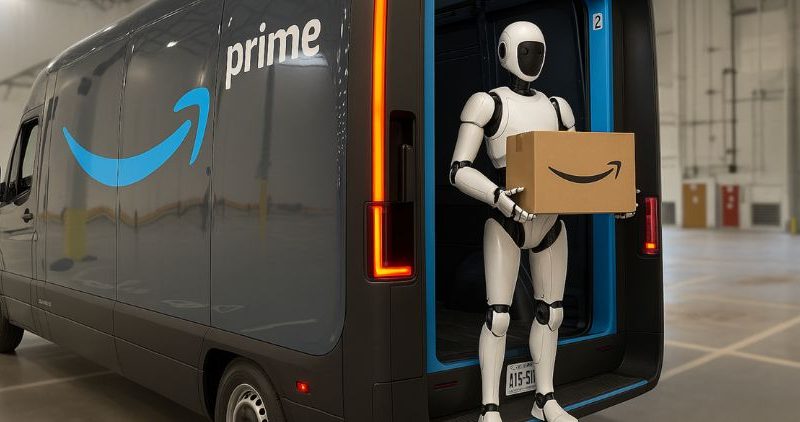Amazon’s Delivery Robots: A New Era for Door-to-Door Deliveries

Amazon is working on a bold new idea: robots that move like humans to deliver packages right to your doorstep. These humanoid robots could change how we get our online orders. They aim to make deliveries faster and cheaper. This article explores Amazon’s latest project, its challenges, and what it means for the future.
What Are Amazon’s Humanoid Delivery Robots?
Amazon is testing robots that walk and act like humans to deliver packages. These robots are designed to step out of delivery vans and bring packages to your door. Unlike older robots with wheels, these new ones can climb stairs and navigate tricky paths. Amazon is building a special testing area in San Francisco to train these robots. This “humanoid park” mimics real-world delivery challenges, like steps and doorways.
I once ordered a book from Amazon and watched the delivery person struggle with my apartment’s steep stairs. A robot that can handle those steps could make deliveries smoother. The idea is exciting, but it’s still in early testing. Amazon wants these robots to work alongside human drivers for now, speeding up drop-offs.
How Do These Robots Work?
- Human-Like Movement: The robots use legs to walk, not wheels, so they can handle uneven ground.
- AI Power: Advanced artificial intelligence helps them understand directions and avoid obstacles.
- Van Integration: They ride in Amazon’s electric Rivian vans and “spring out” to deliver packages.
Pros and Cons of Humanoid Delivery Robots
| Pros | Cons |
|---|---|
| Faster deliveries with robots and humans working together | High cost to build and maintain robots |
| Can work 24/7 without breaks | May not handle complex or unexpected obstacles well |
| Reduces physical strain for human workers | Could reduce jobs for delivery workers |
This section explained Amazon’s new robots and how they aim to improve deliveries. Next, we’ll look at why Amazon is investing in this technology.
Why Is Amazon Developing These Robots?
Amazon wants to make deliveries faster and save money. With over 20,000 electric Rivian vans already in use, the company is always looking for ways to improve. Humanoid robots could handle repetitive tasks, like carrying packages to doors, while humans drive the vans. This could speed up deliveries, especially during busy times like the holidays.
I remember waiting days for a package during a holiday rush. If robots could help during those peak times, it might mean quicker deliveries for everyone. Amazon is also using AI to make these robots smart enough to understand their surroundings. This project is part of a bigger plan to automate more of their delivery system.
Key Goals of Amazon’s Robot Project
- Efficiency: Robots can deliver packages while human drivers focus on driving.
- Cost Savings: Automation could lower labor costs over time.
- Safety: Robots can take on physically demanding tasks, reducing injuries for workers.
Challenges to Overcome
| Challenge | Description |
|---|---|
| Navigation | Robots must handle diverse environments like lawns or crowded sidewalks. |
| Cost | Building and maintaining robots is expensive. |
| Public Acceptance | People may feel uneasy about robots at their doors. |
This section covered Amazon’s reasons for developing these robots and their goals. Now, let’s explore the technology behind them.
The Technology Behind Humanoid Robots
Amazon is using advanced artificial intelligence to power these robots. The AI helps them understand commands, avoid obstacles, and pick the right package. For example, the robots use software similar to what powers self-driving cars. They can “see” their surroundings and make decisions on the spot. Amazon is also testing robots from companies like Unitree, which makes a $16,000 model called the G1.
When I saw a video of a Unitree robot climbing stairs, I was amazed at how human-like it moved. But these robots are still learning. Amazon’s “humanoid park” is like a playground where they practice real-world tasks. The company is also working on AI that lets robots follow natural language instructions, like “place the package by the door.”
Technology Breakdown
- AI Software: Helps robots understand and respond to commands.
- Sensors: Allow robots to detect obstacles and navigate safely.
- Hardware: Built by partners like Unitree, with Amazon focusing on the software.
Pros and Cons of the Technology
| Pros | Cons |
|---|---|
| Smart navigation for complex environments | Technology is still developing and may fail in unpredictable situations |
| Can follow natural language commands | Requires constant updates and maintenance |
| Works with existing delivery vans | Expensive to scale across millions of deliveries |
This section described the technology powering Amazon’s robots. Next, we’ll look at how these robots might affect delivery workers and society.
Impact on Workers and Society
Amazon’s robots could change the job of delivery workers. In the short term, they might help by taking over repetitive tasks. But in the long run, some worry that robots could replace human workers. Amazon says it’s hiring for roles like robot maintenance, but not everyone is convinced. The company has faced criticism for how it treats workers, and this project raises new questions.
I once chatted with a delivery driver who said the job was tough but rewarding. If robots take over, people like him might need new skills. Society will also need to adjust to seeing robots on doorsteps. Some might find it cool, while others might feel uneasy. Learn more about Amazon’s robotics efforts at aboutamazon.com.
Potential Benefits for Society
- Faster Deliveries: Robots could make same-day delivery more common.
- Safer Workplaces: Robots can handle heavy lifting, reducing injuries.
- New Jobs: Roles in robot maintenance and AI development could grow.
Potential Drawbacks
| Issue | Impact |
|---|---|
| Job Losses | Some delivery jobs may disappear over time. |
| Public Trust | People may not trust robots with their packages. |
| Regulation | Laws may limit where robots can operate. |
This section discussed how robots might affect workers and society. Now, let’s look at what the future holds for this project.
The Future of Amazon’s Delivery Robots
Amazon’s humanoid robots are still in the testing phase, but the future looks promising. The company plans to take the robots on “field trips” to test them in real neighborhoods. If successful, they could be part of Amazon’s delivery fleet by 2030. Other companies, like Tesla and Boston Dynamics, are also working on similar robots, so Amazon isn’t alone in this race.
I can imagine a future where a robot drops off my package while I’m at school. It sounds like something from a sci-fi movie, but it’s getting closer to reality. Explore more about robotics trends at techcrunch.com. However, challenges like cost, regulations, and public acceptance will need to be solved first.
What’s Next for Amazon’s Robots?
- Real-World Testing: Field trips to test robots in actual neighborhoods.
- Scaling Up: Expanding the program to more cities if tests succeed.
- Integration: Combining robots with drones and self-driving vans for full automation.
Future Possibilities vs. Challenges
| Possibility | Challenge |
|---|---|
| Fully automated delivery system | High costs and technical issues |
| 24/7 delivery without human limits | Regulatory hurdles in different states |
| Improved customer experience | Public resistance to robot deliveries |
This section looked at the future of Amazon’s robots and the challenges ahead. Now, let’s wrap up with some final thoughts.
Final Thoughts on Amazon’s Robot Revolution
Amazon’s humanoid delivery robots could change how we get our packages. They promise faster, cheaper deliveries, but they also bring challenges like job concerns and technical hurdles. As Amazon tests these robots, the world is watching to see if they can live up to the hype. For now, it’s an exciting step toward a more automated future, but it’s not without risks.





